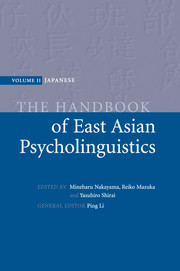Book contents
- Frontmatter
- Contents
- List of figures
- List of contributors
- In memory of Miwa Nishimura
- Preface
- Introduction
- Language acquisition
- 1 Ontogeny of language
- 2 Caregivers' speech
- 3 The intrinsic link between gesture and speech at the prelinguistic stage
- 4 Infant speech perception
- 5 Phonological acquisition
- 6 The mechanism of lexical development: implications from Japanese children's word learning
- 7 The acquisition of nouns and verbs in Japanese
- 8 The acquisition of verbal nouns
- 9 The acquisition of Japanese numeral classifiers
- 10 The acquisition of case markers
- 11 The acquisition of tense and aspect
- 12 On the origin of children's errors: the case of Japanese negation and direct passive
- 13 Binding Theory in UG and first-language acquisition of Japanese
- 14 The acquisition of the particles ne, yo, and no
- 15 The acquisition of linguistic politeness in Japanese
- 16 Children's narrative structures
- 17 Memory talk and testimony in children
- 18 Developmental dyslexia
- 19 Japanese Sign Language
- 20 The role of an innate acquisition device in second-language acquisition
- 21 Japanese, the grammar of reflexives, and second-language acquisition
- 22 Processes in L2 Japanese sentence production
- 23 The development of lexical competence among second-language readers
- 24 Reading in Japanese as a second language
- 25 Intrasentential code-switching in Japanese and English
- Part II Language processing
- References
- Name index
- Subject index
9 - The acquisition of Japanese numeral classifiers
from Language acquisition
Published online by Cambridge University Press: 05 June 2012
- Frontmatter
- Contents
- List of figures
- List of contributors
- In memory of Miwa Nishimura
- Preface
- Introduction
- Language acquisition
- 1 Ontogeny of language
- 2 Caregivers' speech
- 3 The intrinsic link between gesture and speech at the prelinguistic stage
- 4 Infant speech perception
- 5 Phonological acquisition
- 6 The mechanism of lexical development: implications from Japanese children's word learning
- 7 The acquisition of nouns and verbs in Japanese
- 8 The acquisition of verbal nouns
- 9 The acquisition of Japanese numeral classifiers
- 10 The acquisition of case markers
- 11 The acquisition of tense and aspect
- 12 On the origin of children's errors: the case of Japanese negation and direct passive
- 13 Binding Theory in UG and first-language acquisition of Japanese
- 14 The acquisition of the particles ne, yo, and no
- 15 The acquisition of linguistic politeness in Japanese
- 16 Children's narrative structures
- 17 Memory talk and testimony in children
- 18 Developmental dyslexia
- 19 Japanese Sign Language
- 20 The role of an innate acquisition device in second-language acquisition
- 21 Japanese, the grammar of reflexives, and second-language acquisition
- 22 Processes in L2 Japanese sentence production
- 23 The development of lexical competence among second-language readers
- 24 Reading in Japanese as a second language
- 25 Intrasentential code-switching in Japanese and English
- Part II Language processing
- References
- Name index
- Subject index
Summary
Introduction
It is a fundamental human cognitive activity to categorize objects and events in order to have a cohesive understanding of the world. While one can claim that mapping between conceptual categories and grammatical forms is arbitrary, it is undeniable that conceptual categories are revealed in different noun or nominal classifying systems in the languages of the world. Among these systems are noun classes or genders, numeral classifiers, verbal classifiers, locative and deictic classifiers, and genitive or possessive classifiers (for more extensive coverage of classifiers, see Aikhenvald, 2000).
Numeral classifiers, which are widespread across the languages of East and Southeast Asia and Oceania, are a grammatical system that reflects how speakers categorize objects that they count or quantify. They classify nouns on the basis of their referents' attributes, such as animate versus inanimate, human versus animal, and shape versus function of referents. Therefore, patterns of acquisition of classifiers are an important source of information about underlying patterns of semantic and conceptual development (Adams & Conklin, 1973; Clark, 1977; Muraishi, 1983; Craig, 1986; Matsumoto, 1987; Carpenter, 1987, 1991). Earlier, researchers like Adams and Conklin (1973) proposed that animacy and shape were universal features of numeral classifiers, stressing the possibility that classifier systems reflect basic cognitive categories despite their cultural or language-family specificity. More recently, within the context of the ongoing debate on linguistic relativity, Lucy (1992a, 1992b) and Lucy and Gaskins (2001) have asserted that the acquisition of numeral classifiers might influence conceptual development itself, because classifier languages have no syntactic distinction between mass and count nouns.
- Type
- Chapter
- Information
- The Handbook of East Asian Psycholinguistics , pp. 69 - 75Publisher: Cambridge University PressPrint publication year: 2006



